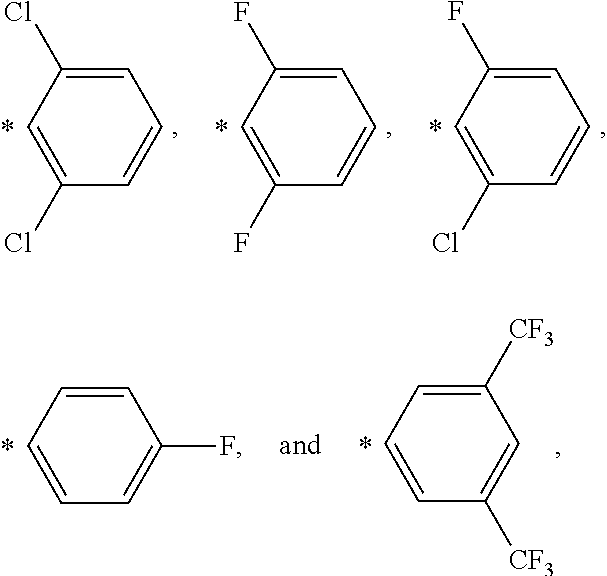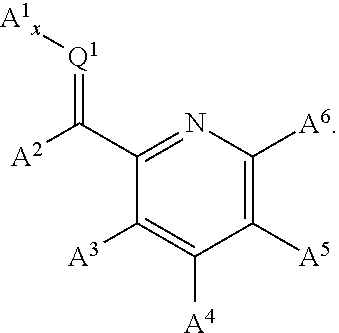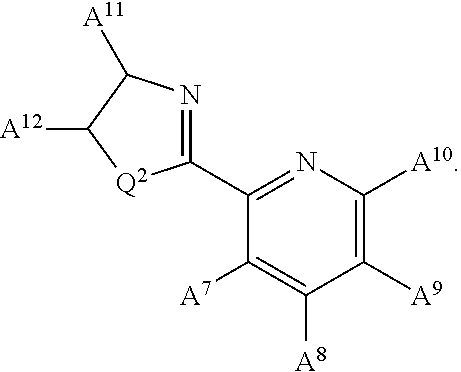Nickel containing hydrosilylation catalysts and compositions containing the catalysts
a hydrosilylation catalyst and catalyst technology, which is applied in the direction of catalyst activation/preparation, group 5/15 element organic compounds, iron organic compounds, etc., can solve the problems of difficult preparation of hydrosilylation catalysts, difficult to obtain metals in these hydrosilylation catalysts, and high cost of hydrosilylation catalysts
- Summary
- Abstract
- Description
- Claims
- Application Information
AI Technical Summary
Benefits of technology
Problems solved by technology
Method used
Image
Examples
example 1
Formation of Metal-Ligand Complexes
[0266]Precursor solutions were prepared by mixing a Ni precursor at a 0.025 molar (M) concentration with THF or, if the precursor was insoluble in THF, then a suitable solvent to dissolve the ligand selected from dimethylsulfoxide (DMSO), toluene, and hexane. Nickel (II) bromide dimethoxyethane, and Nickel (II) bis trimethylsilyl amide were used as the Ni precursors. Solutions of each ligand shown above in Table 2 were also prepared by mixing the ligand at a 0.025 M concentration with THF. Each ligand solution prepared above was dispensed into 2 milliliter (mL) vials at 85 microliters (μL) per vial. To prepare samples to evaluate as ingredient (A), one of the metal precursor solutions described above was added to a vial containing a ligand, and an additional 85 microliters (μL) THF was added, and the vial contents were mixed at 300 RPM at room temperature of 25° C. for 2 hours. A sufficient amount of metal precursor solution was added such that the...
example 2
[PhSi] Reaction
[0267]To perform the [PhSi] reaction, PhSiH3 (C2) in dodecane and 1-hexene (B3) were added to a vial prepared according to Example 1. The amount of PhSiH3 (C2) added to the vial was either 170 μL of 6.25 M (as H or SiH) PhSiH3 (C2) in dodecane, or 132.4 μL PhSiH3 (C2) in 37.6 μL dodecane. The amount of 1-hexene (B3) was 145 μL. Each vial was mixed overnight (for 16 h) at 50° C. The resulting contents of each vial were analyzed by GC according to the method described below.
example 3
[HMTS] Reaction
[0268]To perform the [HMTS] reaction, 1-hexene (B3) and 1,1,1,3,5,5,5-heptamethyltrisiloxane (C1) were added to a vial prepared according to Example 1. The amount of 1-hexene added was 145 μL. The amount of heptamethyltrisiloxane (C1) was either 312 μL heptamethyltrisiloxane (C1) at a concentration of 3.4 M (as H or SiH) in dodecane, or 290 μL heptamethyltrisiloxane (C1) in 22 μL dodecane. Each vial was mixed overnight (for 16 h) at 50° C. The resulting contents of each vial were analyzed by GC according to the method described below.
PUM
| Property | Measurement | Unit |
|---|---|---|
| temperature | aaaaa | aaaaa |
| temperature | aaaaa | aaaaa |
| temperature | aaaaa | aaaaa |
Abstract
Description
Claims
Application Information
 Login to View More
Login to View More - R&D
- Intellectual Property
- Life Sciences
- Materials
- Tech Scout
- Unparalleled Data Quality
- Higher Quality Content
- 60% Fewer Hallucinations
Browse by: Latest US Patents, China's latest patents, Technical Efficacy Thesaurus, Application Domain, Technology Topic, Popular Technical Reports.
© 2025 PatSnap. All rights reserved.Legal|Privacy policy|Modern Slavery Act Transparency Statement|Sitemap|About US| Contact US: help@patsnap.com



